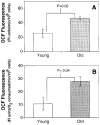Oxidative stress in the aging rat heart is reversed by dietary supplementation with (R)-(alpha)-lipoic acid
- PMID: 11259388
- PMCID: PMC4696539
- DOI: 10.1096/fj.00-0176com
Oxidative stress in the aging rat heart is reversed by dietary supplementation with (R)-(alpha)-lipoic acid
Abstract
Oxidative stress has been implicated as a causal factor in the aging process of the heart and other tissues. To determine the extent of age-related myocardial oxidative stress, oxidant production, antioxidant status, and oxidative DNA damage were measured in hearts of young (2 months) and old (28 months) male Fischer 344 rats. Cardiac myocytes isolated from old rats showed a nearly threefold increase in the rate of oxidant production compared to young rats, as measured by the rates of 2,7-dichlorofluorescin diacetate oxidation. Determination of myocardial antioxidant status revealed a significant twofold decline in the levels of ascorbic acid (P = 0.03), but not alpha-tocopherol. A significant age-related increase (P = 0.05) in steady-state levels of oxidative DNA damage was observed, as monitored by 8-oxo-2'-deoxyguanosine levels. To investigate whether dietary supplementation with (R)-alpha-lipoic acid (LA) was effective at reducing oxidative stress, young and old rats were fed an AIN-93M diet with or without 0.2% (w/w) LA for 2 wk before death. Cardiac myocytes from old, LA-supplemented rats exhibited a markedly lower rate of oxidant production that was no longer significantly different from that in cells from unsupplemented, young rats. Lipoic acid supplementation also restored myocardial ascorbic acid levels and reduced oxidative DNA damage. Our data indicate that the aging rat heart is under increased mitochondrial-induced oxidative stress, which is significantly attenuated by lipoic acid supplementation.
Figures





References
-
- Cohn JN, Bristow MR, Chien KR, Colucci WS, Frazier OH, Leinwand LA, Lorell BH, Moss AJ, Sonnenblick EH, Walsh RA, et al. Report of the National Heart, Lung, and Blood Institute Special Emphasis Panel on Heart Failure Research. Circulation. 1997;95:766–770. - PubMed
-
- Sawada M, Carlson JC. Changes in superoxide radical and lipid peroxide formation in the brain, heart and liver during the lifetime of the rat. Mech Ageing Dev. 1987;41:125–137. - PubMed
-
- Nohl H, Hegner D. Do mitochondria produce oxygen radicals in vivo? Eur J Biochem. 1978;82:563–567. - PubMed
-
- Sohal RS, Ku HH, Agarwal S, Forster MJ, Lal H. Oxidative damage, mitochondrial oxidant generation and antioxidant defenses during aging and in response to food restriction in the mouse. Mech Ageing Dev. 1994;74:121–133. - PubMed
-
- Haramaki N, Han D, Handelman GJ, Tritschler HJ, Packer L. Cytosolic and mitochondrial systems for NADH—and NADPH-dependent reduction of alpha-lipoic acid. Free Radic Res Med. 1997;22:535–542. - PubMed
Publication types
MeSH terms
Substances
Grants and funding
- DK48831/DK/NIDDK NIH HHS/United States
- R01 AG017141/AG/NIA NIH HHS/United States
- P30 DK026657/DK/NIDDK NIH HHS/United States
- R01 GM042056/GM/NIGMS NIH HHS/United States
- DK26657/DK/NIDDK NIH HHS/United States
- RIAG17141A/AG/NIA NIH HHS/United States
- GM15431/GM/NIGMS NIH HHS/United States
- R01 DK048831/DK/NIDDK NIH HHS/United States
- P01 CA077839/CA/NCI NIH HHS/United States
- P01 GM015431/GM/NIGMS NIH HHS/United States
- R37 GM042056/GM/NIGMS NIH HHS/United States
- P50 GM015431/GM/NIGMS NIH HHS/United States
- GM42056/GM/NIGMS NIH HHS/United States
- CA77839/CA/NCI NIH HHS/United States
LinkOut - more resources
Full Text Sources
Other Literature Sources
Medical

